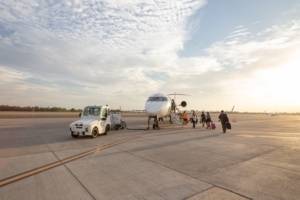Why go for Electric/Hybrid solutions for GSEs?
PMSM and BLDCs for Ground Support Equipment
Permanent Magnet motors come with powerful batteries that ensure long operating times. PMSMs have a life expectancy greater than their batteries. This exceeds a traditional airplane tug by far. An direct drive BLDC or PMSM does not require a transmission, oil system, or cooling system of the same strength as that of an Internal Combustion engine. It does not require a starter motor, alternator, or brake pad that are in constant use. A well fitted PMSM or BLDC eradicates, almost completely, the need for scheduled and regular maintenance.
Additionally, PMSMs and BLDCs are silent, while also eliminating exhaust fumes. Thereby they provide a two-fold advantage: an unpolluted work environment and a fuel-efficient ground support solution.
 Some other benefits of Electric GSEs are as follows:
Some other benefits of Electric GSEs are as follows:
- Lower costs of operation
- High energy-conversion efficiency
- Precise and smooth movement due to uninterrupted torque on demand
- “Regenerative Braking” returns energy to the battery upon application of the brakes.
- Dynamic braking reduces the wear & tear of the brakes.
28 Vdc Generators
Most GSEs have a specific requirement of 28V of Direct Current. Including a hybrid drivetrain increases the up-time of the tugs and belt loaders. Once the battery reaches a lower limit charge level, the engine kicks in and charges up the batteries. Using an electric or hybrid Auxiliary Power Unit (APU) is the most effective way to fulfil all your energy needs. This ensures longer run-times and significantly reduced emissions with lower fuel costs.
At Innotec, we design and manufacture our own “DC Generator Heads”, thereby allowing us to customize our products to build you an system that matches the power, voltage and rpm specifications of your choice. These “Generator Heads” are 3-phase permanent magnet alternators, that couple with an external rectifier. This type of alternator is in many large wind turbine installations and inverter generators on the market and is most ideal for use with airport GSE.
We manufacture three kinds of Generator Heads for DC Voltage:
- Engine-Mounted DC Generator Heads
- Pulley-Driven DC Generator Heads
- Hydraulic Driven DC Generator Heads
Whichever generator head is most suitable for your needs depends on the hybrid set-up configuration. Our unique selling point, however, is the high efficiency of our generator heads. High levels of customization and superior material grades can increase efficiency and life cycle.
Successful DC Generator Customers
For more than a decade of successful deployments in the telecom sector, hybrid vehicle installations and auxiliary DC power generators, Innotec possesses the technical expertise to customize its generator heads almost entirely to suit every client’s specific needs. We guarantee the highest efficiency in comparison to anything else available in the market, custom configurations and most importantly, the maximum kilowatt (kW) to weight ratios, while maintaining the generators’ minimal size.
Background for Hybrid & Electric Ground Support Equipment
Ground Support Equipment (GSE) refers to the machines used to maintain an aircraft and ensure its fitness for flight during its grounded phases. Generally these machines stay close to the terminal when not in use for easier accessibility. Their main objective is to ensure the safe operation of the aircraft between landing and resuming flight.
Ground Support Equipment can be majorly classified into powered and non-powered equipment, depending upon the kind of assistance they provide.
Non-Powered Equipment includes dollies (for transporting heavy and cumbersome objects), chocks (for preventing the aircraft’s movements while grounded) and aircraft jacks (to prevent aircraft from becoming tail-heavy).
 GSE Power Equipment
GSE Power Equipment
Powered Equipment, on the other hand, has a much wider range of products including, but not limited to:
- Aircraft Re-fuelers: Trucks, for the purpose of refueling, store nearly 50,000 liters of fuel. Smaller hydrant system carts connect to the re-fueler truck and can simplify refueling for airports by providing more refueling options.
- Container Loader: Referred to as “K-loaders”; load and unload pallets on and off an aircraft. They have two independently controllable platforms, along with built-in wheels or rollers, making these units mobile.
- Lavatory Service Loaders: This equipment disposes of waste and cleans lavatories for use again. Airplanes store their waste in tanks till their time of landing and the arrival of lavatory service vehicles for disposing of the same.
- Tugs: Tugs transport equipment (i.e. baggage carts) too heavy to push around.
- Belt Loaders: Belts Loaders are vehicles with a conveyor belt design for easy unloading and loading of cargo and baggage onto an airplane. These are at an aircraft hold’s door sill, where they can quickly handle cargo.
- Buses: Also referred to as “Airport Buses”, “People-Movers” or “Mobile Lounges”, these buses transport people from a terminal to either other terminals, or an aircraft. They resemble standard city buses, but can also be an airport bus.
- Ground Power Units: Mobile auxiliary power units used as a source of power for parked aircraft.
- Transporters: Uncommon in the US, but still prevalent in airports globally. Their USP is that they transport cargo, not just for their loading & unloading.
- Catering Vehicles: Deliver meals using these vehicle carts that assist with the loading and unloading of food and beverages for passengers and crew.
